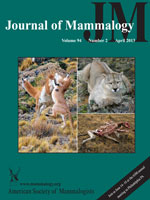It is well established that massive consumption of plants by the abundant and diverse assemblage of savanna ungulates in East Africa competitively suppresses the native guild of herbivorous to omnivorous small mammals. An important role of woody plant suppression in the Acacia-dominated savannas for this guild of rodents, when released from ungulate competition, has been demonstrated only recently, but without direct evidence of which species are involved. In an effort to establish which of the common species in this guild are most likely to impact growth of trees and forbs, as opposed to grasses or insects, or both, I present data on atomic and isotopic ratios of fecal carbon and nitrogen from 8 commonly occurring muroid rodents from savanna and bush habitats on the Laikipia Plateau of central Kenya: Acomys percivali, Acomys wilsoni, Aethomys hindei, Arvicanthis niloticus, Mastomys natalensis, Mus spp. (thought to be mostly M. minutoides), Saccostomus mearnsi, and Gerbilliscus robustus. In this region where all grasses are C4 and all trees and other nongrasses are C3, different ratios of 13C:12C (δ13C) in plant tissues give pure grazers, pure browsers, and mixed-feeding herbivores distinctive carbon isotope signatures. Degree of omnivory is revealed by C:N and, arguably, by δ15N, but the latter is influenced by dietary protein quality and varies widely by plant species and soil type. Joint consideration of stable-isotope data, total C:N, and microhistological analysis of feces allowed better resolution of dietary niche of each species than any of these data sets could, alone. Grass was either coequal to browse (dicots) or dominated the plant portion of each species' diet, which was somewhat unexpected given rodents' hypothesized role in limiting Acacia recruitment. All species consumed some arthropods. A. niloticus, the only diurnal species, was the most herbivorous, being largely a grazer. S. mearnsi, A. hindei, and M. natalensis were mixed-feeding (grass–browse) herbivores. Mus spp. and Acomys spp. were omnivores whose plant components were largely grass. G. robustus was primarily an insectivore–omnivore whose smaller plant component was grass. Both S. mearnsi and A. niloticus displayed a significant increase in proportion of C4 grasses in the diet in periods following significant rains, a pattern previously documented from δ13C diet studies in large mammalian herbivores. Fecal δ15N was significantly higher for rodents that consumed more grass and for rodents released from competition with ungulates, suggesting a partial mechanism for that competitive release. S. mearnsi, followed by A. hindei and M. natalensis, were most likely to feed on woody dicots including Acacia.
How to translate text using browser tools
1 April 2013
Would East African savanna rodents inhibit woody encroachment? Evidence from stable isotopes and microhistological analysis of feces
Bradley J. Bergstrom
ACCESS THE FULL ARTICLE

Journal of Mammalogy
Vol. 94 • No. 2
April 2013
Vol. 94 • No. 2
April 2013




